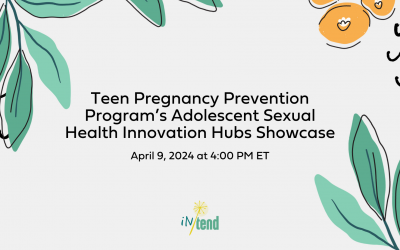
Statement from Healthy Teen Network on the Observance of the National Month to Prevent Teen Pregnancy.

By Patricia Paluzzi, CNM, DrPH
May 8, 2014
As Healthy Teen Network participates in the 13th annual observance of the National Teen Pregnancy Prevention Month, we are encouraged by the news that rates of pregnancies and births to United States youth below age 20 have declined over the past two decades. Landmark research by John Santelli and others suggests that this decline is entirely attributable to increased contraceptive use among older youth (18 and 19 years old) and primarily attributable to improved contraceptive use among 15- to 17-year olds.
This evidence implies that further reductions in teen pregnancies and births will occur when more youth can gain access to contraceptives and, associated with that access, education and skills about using contraceptives—such as negotiating contraceptive use between sex partners.
This evidence implies that further reductions in teen pregnancies and births will occur when more youth can gain access to contraceptives and, associated with that access, education, and skills about using contraceptives—such as negotiating contraceptive use between sex partners. Thus we are encouraged by the recent release of new recommendations outlining how to provide quality family planning services by the Centers for Disease Control and Prevention and the Office of Population Affairs of the U.S. Department of Health and Human Services. We hope these recommendations will spark continued improvements in family planning services to adolescents.
Positive news notwithstanding, teen pregnancies and births continue to occur in high rates. Contributing to this condition are believed to be factors such as low sexual health literacy and discomfort among some adult family members in discussing matters of sexuality with their children; lack of universal school-based comprehensive sexuality education; inability to implement teen pregnancy prevention (TPP) evidence-based interventions (EBIs) on a widespread basis due to cost and complexity and low levels of public funding; unavailability of TPP EBIs tailored to some marginalized subpopulations; policies and practices that prevent youth from accessing contraceptives; and behavior messages from media that glamorize sexual activity. And then there are the constellation of social determinants, including poverty and intimate partner violence, which compound the problem. Clearly, teen pregnancy is not a single issue focus or fix, but one that requires collaboration from multiple agencies and individuals, and especially youth.
A Month to Educate, Energize, and Empower
Like many others working in the adolescent sexual and reproductive health field, Healthy Teen Network uses the opportunity presented by the National Teen Pregnancy Prevention Month to educate the public, press, and policymakers of the work that remains to be done to reduce teen pregnancy rates in the United States. We also utilize the Month to energize our field and validate its excellent work. And certainly, the Month provides an opportunity to empower and showcase young people who are leading efforts in their schools and communities to educate peers about sexual and reproductive health, or who are simply taking a moment to educate themselves about the risk factors and protective factors of teen pregnancy.
Unfortunately, the Month also becomes the season when negative messages around teen pregnancy crop up. Most harmful are messages that teen parents are “bad girls making bad choices.” Healthy Teen Network opposes such shaming.
We refuse to assign negative value to any young person due to his or her parenting status. Nor do we forget that pregnancy among and births to teens (and adults for that matter) is not always a choice.
We refuse to assign negative value to any young person due to his or her parenting status. Nor do we forget that pregnancy among and births to teens (and adults for that matter) is not always a choice. We congratulate the young mothers who have persisted in a messaging campaign and movement, #NoTeenShame, to raise awareness regarding the unnecessary exploitation and stigmatization of teen mothers.
Furthermore, negative messages about teen parents exclude them from important sub-messaging around pregnancy prevention: the delaying and spacing of subsequent childbearing. Healthy Teen Network asserts that with support and resources, adolescents who are parents can be effective parents. For us, there cannot be an inclusive National Teen Pregnancy Prevention Month without including teen parents in the conversation and the solution.
Also of concern are messages that suggest teen parenting is costly to the public—another form of shaming, but in a public policy context. We recognize the surface attractiveness of this message. It can be an effective tactic to engage those who are unpersuaded by explanations of the social-ecological causes of teen pregnancy and parenting and more prone to assign blame to teen parents for personal failings. But we must be cautious and strategic in its use, or we risk damage to teen families.
Moreover, cost arguments about teen parenting have their own set of pitfalls. These arguments operate on a disease prevention theory. Healthy Teen Network does not ascribe to this theory, as we do not consider teen pregnancy or parenting to be a disease in need of treatment. Rather, it is a fact of life affecting a small number of U.S. youth and their families annually. Yes, in order to be prepared to fully participate in modern life, adolescents and young adults need generous opportunities to pursue education and other enrichments—opportunities which are enhanced by delaying and spacing childbearing. Prevention is a priority for Healthy Teen Network. But so is supporting those young people with children
Investing in Our Youth and Families
Public costs associated with raising and supporting children and families are not unique or isolated to teen families. Having children is costly to society, regardless of the age of the parent. We have reached an obvious conclusion that children are good for a society (minimally for the society’s self-preservation), and that the benefits outweigh the costs—the costs are, truly, investments.
These cost arguments tend to characterize public expenditures for supporting teen families as “burdens.” Granted, there may be higher costs to raising children born to teens because this population tends to need additional supports due to the economic status and developmental stage of the teen parent. Healthy Teen Network suggests instead that these costs also are investments. A classic illustration is that studies report high public health insurance (i.e., Medicaid) costs associated with teen families. We would counter-argue: isn’t it more cost-efficient to health insure a family than not? And would we deny publicly-funded health insurance to families simply because of the age of the parent? The reality is that some of our nation’s families are fragile due to all manner of causes, and that fragility does not discriminate by parental age. The American people do not want any of our nation’s families to fail. Healthy Teen Network asserts that teen families should not be allowed to fail either.
Like most parents, pregnant and parenting teens are extremely motivated to offer their children a good life. They quickly realize that an education and a career are necessary, and with the right supports, they will complete high school and eagerly seek further education or training. With help from their families, other caring adults, and public and private asset-building resources and services, they can avoid some of the challenges they might otherwise face. Healthy Teen Network’s new infographic, “Picture Perfect: A Snapshot of What Helps Teen Families Grow & Thrive,” illustrates these opportunities.
An Inclusive, Youth 360° Approach
In fact, what helps teen families grow and thrive is not so very different from what helps all families thrive. To improve outcomes (that is, to reduce teen pregnancies and births), we need to recognize the complex interrelated factors, or social determinants—such as access to quality education and health services, life goals and aspirations for the future, or healthy relationships—that influence individual behavior and health outcomes. How and where we live, learn, and play affects every one of us—our health and well-being, even our life span. And so, Healthy Teen Network uses an inclusive, Youth 360° approach to achieve better outcomes for youth across diverse populations, including, most certainly, pregnant and parenting teens.
Not only as we observe the National Teen Pregnancy Prevention Month, but every day, let’s indeed keep our attention on the important work already done and that must continue to support adolescent sexual and reproductive health. But let’s also be sure not to punish teen families, either by shaming them for their life circumstances or by depriving them (or even suggesting to deprive them) of the publicly-funded resources and services they require—just as do older adult-led families—to thrive as contributing members of our American community. A Youth 360° approach to not just prevention, but overall adolescent sexual and reproductive health, is the inclusive and positive messaging we must model to educate, to energize, and to empower not only our field, but the youth, the public, the press, and the policymakers as well.
Patricia Paluzzi, CNM, DrPH, is the former President and CEO of Healthy Teen Network and has been active in the fields of reproductive, and maternal and child health for over 40 years, as a clinician, researcher, administrator, and advocate.













